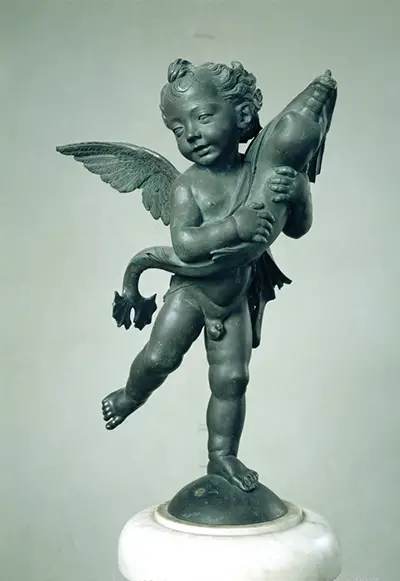One of the most famous Renaissance sculptures of the 15th century is the Putto with Dolphin (Also Little Angel with Dolphin).
Today, a putto is commonly known as a cupid. Apart from the sculpture of David, the Putto with Dolphin is the other sculpture by Verrochio that still survives. The bronze sculpture dates back to before 1476 and was an important development in the 15th century. The Little Angel with Dolphin was originally commissioned for the Medici Villa of Careggi but today, the statue stands at Palazzo della Signoria. It was made at Lorenzo de Medici's request.
The Little Angel with Dolphin is a free-standing sculpture with a spiral design. The statue is that of a little, plump boy with wings. He is naked and in his hands, he holds a dolphin. He has one of his feet lifted off the surface on which he stands. The statue stands balanced in the way in which it projects its limbs and may have been designed in this manner so that the pressure of steam in the fountain where it was to be placed would turn it. The spiral design is important because it provides the viewer with an interesting view of the angel from all angles.
Little Angel with Putti is a bronze sculpture. Bronze is an amalgam of tin and copper and sometimes zinc and lead as well. The material was desirable for sculptures for various reasons. One of them is the strength and durability of the material. Early Europeans used bronze in the production of weapons, decorations and sculptures because of the above qualities. This continued into the 15th century when Renaissance sculptors such as Andrea del Verrocchio took up bronze as a medium of expression. Bronze was also used by Donatello and Lorenzo Ghiberti.
Another reason why artists used bronze is because of the metal's ability to capture the fine intricacies in the casting mould. The techniques used to cast bronze was the sand casting method. Sand casting involves the use of a sand mould, metal, pattern and furnace to produce a metal component. A mould is created by packing sand around the patterns. It is then lubricated and its cores positioned before the halves are clamped together to ensure material is securely held inside it. The bronze is then poured into the mould until it fills in the cavities of the mould. The solid begins to cool in the mould before it is removed from the cast. This is done by breaking the sand, and the trimming process follows. Trimming involves brushing off the remains of the sand from the metal. The sand can then be reused for another cast or discarded.
Some of the artists related to Andrea del Verrocchio include Fra Filippo Lippi who trained him as a painter. Leonardo Da Vinci and Lorenzo di Credi and several other artists were his apprentices. Part of Andrea's The Baptism of Christ was painted by Leonardo Da Vinci. He also influenced the style of Pietro Perugino, Domenico Ghirlandaio and Francesco Botticini.




